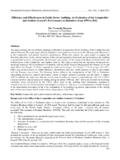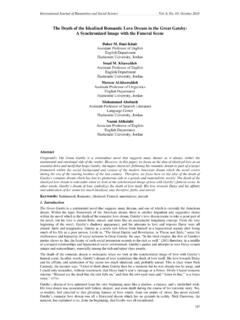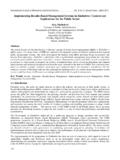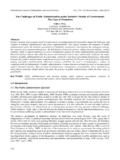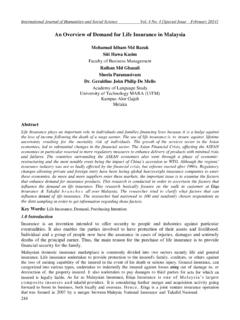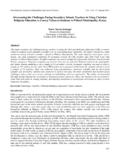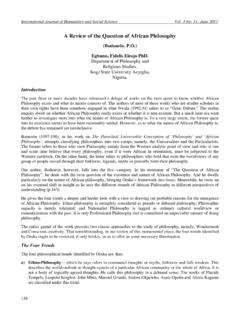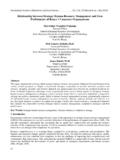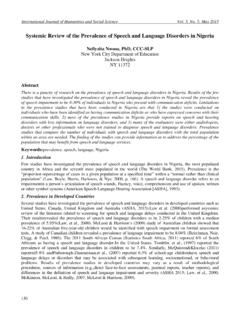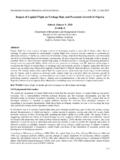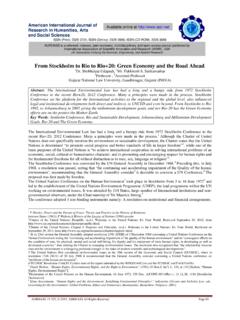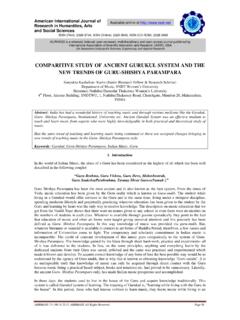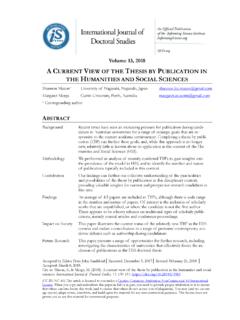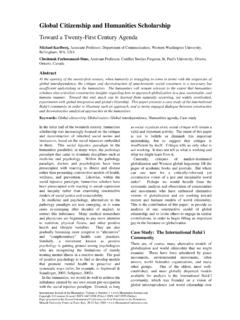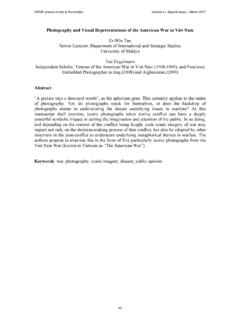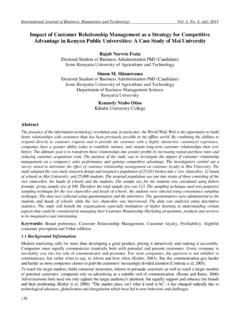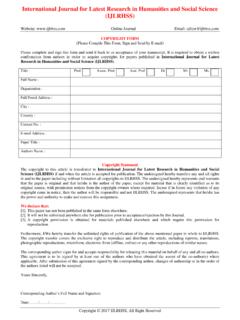Transcription of International Journal of Humanities and Social Science Vol ...
1 International Journal of Humanities and Social Science Vol. 1 No. 11 [Special Issue August 2011] 241 An Examination of the Interaction between Poverty and Health Status in the Elderly Population of Jamaica EDWARDS-WESCOTT, Patricia HEU, Centre for Health Economics The University of the West Indies #25A Warner Street, St. Augustine, Trinidad and Tobago Phone: 1-868-662-9459 E-mail: GITTENS-BAYNES, Kimberly-Ann HEU, Centre for Health Economics The University of the West Indies #25A Warner Street St. Augustine, Trinidad and Tobago Phone: 1-868-662-9459 E-mail: METIVIER, Charmaine (Corresponding author) HEU, Centre for Health Economics The University of the West Indies #25A Warner Street St. Augustine, Trinidad and Tobago Phone: 1-868-662-9459 E-mail: ABSTRACT In the Caribbean, ageing is evident and its associated challenges are many.
2 As we acknowledge these issues we are cognisant that, among other factors, the poverty levels experienced by the elderly adversely affect their health status, well-being and quality of life. This paper examines the link between poverty and health status, within the context of ageing and the emergent threat of chronic non-communicable diseases, to present and future elderly populations in Jamaica. From 7 percent in 1960 to percent in 2001 and expectations of 22 percent elderly in the population by 2050 (STATIN, 2008), practical elder-focused polices in health, Social support and development are proposed to address the impact of poverty on one s health status. Keywords: Ageing, chronic non-communicable diseases, health seeking behaviour, health status, Jamaica, policy recommendations, poverty, quality of life.
3 INTRODUCTION The phenomenon of ageing can be viewed as both an achievement and a challenge for the people of the Caribbean (ECLAC, 2000). The global attainment of increased life expectancy of both males and females reflects in part the gains made in the fields of medical and public health. High mortality and high fertility are features of the past for many countries, however, this achievement has also brought with it a demographic transition which challenges both the health status and the level of Social and economic well-being of the elderly globally and those in the Caribbean are not excluded (CARICOM, 2009). According to ECLAC (2000), the evidence of ageing populations in the Caribbean dates back to the 1960s.
4 This silent revolution is not unique to Latin America and the Caribbean (LAC), but has its genesis in Europe and is can be found in many countries today. Schmid (2006) noted that there are 8 Caribbean countries among the top 50 percent of countries in the world with ageing populations. The United Nations Population Division (United Nations, 2006b) noted that 4 Caribbean countries Barbados, Puerto Rico, Netherlands Antilles and Trinidad and Tobago had already attained an under replacement level of less than children per woman and all other countries, but Haiti, were poised to achieve this condition before the next 10 years had elapsed. The challenge is that as the Caribbean goes through this transition its older persons enjoy not only longer lives, but also better quality life-years.
5 This paper is divided into 4 broad sections. Following this introduction, section 2 examines the Caribbean with respect to the demographic, epidemiological and economic situations facing the elderly. Section 3 examines similar issues with specific reference to the situation of the elderly in Jamaica. The Special Issue on Arts and Social Science Centre for Promoting Ideas, USA 242 Finally, section 4 provides timely recommendations to improve the situation of the elderly in the Caribbean 2. AGEING IN THE CARIBBEAN Demographics of the Elderly In LAC, the segment of the population identified as the elderly or older persons comprises those who are aged 60 years and over.
6 This cohort is by no means homogenous and can be further broken down into the younger elderly, 60 to 74 years, and the older elderly, 75 years and over (ECLAC, 2000). The 2000 census data for 16 countries of the Caribbean Community (CARICOM) show that the older population is growing at a faster rate (25 percent) than the total population (9 percent) (CARICOM, 2009). For the wider Caribbean, persons aged 75 years and older accounted for approximately 20 percent of the older population in 1950, which rose to 28 percent in 2010 and is estimated to increase to 39 percent by 2050. Table and Figure illustrate the observed and estimated changes in the demographic structure of the Caribbean s population between 1950 and 2050.
7 Health of the Elderly Life expectancy in the Caribbean has increased dramatically over the last 50 years (PAHO/MIAH, 2004), mainly because of improvements in health care, sanitation and nutrition. Changes in the demographic profile of the Caribbean, accompanied by an epidemiological transition where degenerative life-style diseases have replaced infectious and acute diseases as major causes of premature death, are observed. As early as 1997, some 70 percent of those seeking medical care for chronic diseases were older persons (ECLAC, 2000). Among the elderly, the major causes of morbidity were hypertension and arthritis (Schmid, 2006). The 2000 population census data on the prevalence of 3 illnesses - arthritis, diabetes and hypertension - in 10 CARICOM countries show that women accounted for 65 percent of all reported arthritis cases and 61 percent of all reported hypertensive cases while men reported 52 percent of the diabetes cases (CARICOM, 2009).
8 Poverty Poverty has existed on the landscape of the Caribbean for many decades and still persists today in spite of relatively favourable human development indicators of many countries (ECLAC, 2004). In 1996, the level of poverty in the Caribbean was estimated at 38 percent (World Bank, 1996), but had fallen to 30 percent by 2002 (CDB, 2002). According to Schmid (2006), the vulnerability of older persons to poverty increases because their ability to earn income is lower than those in younger age groups. Old age poverty in the Caribbean is by no means a uniform phenomenon. Elderly women in the main tend to be more prone than men to fall into poverty.
9 Further, a number of elderly women, who are often without financial assistance or regular income, are often saddled with caring for grandchildren when their children migrate in search of better opportunities (ECLAC, 2004). To improve the situation, a number of safety net schemes have been provided to reduce poverty among the elderly (UNFPA, ). Formal safety net programmes include Social insurance schemes, contributory and non-contributory old-age pensions, Social public assistance and funds, in-kind assistance, and residential homes (World Bank, 1996). However, both the value of Social assistance offered and the number of persons who benefit from these schemes are low. Like Government pension schemes, the coverage of non-contributory old age pension schemes is varied - as low as 5 percent (Grenada) in some countries while as high as 80 percent (Trinidad and Tobago) in others.
10 Consequently, many older persons in the Caribbean are forced to rely on financial and/or in-kind resources from family and civil society in order to attempt to escape poverty and destitution (ECLAC, 2004). The case of the elderly and the prevalence of chronic health conditions and poverty among them will next be highlighted by examining the situation of ageing in Jamaica. 3. JAMAICA Overview of Ageing in Jamaica Jamaica, like many of its Caribbean neighbours, is experiencing a demographic transition marked by an increase in its elderly population. According to census data, the elderly population has been steadily increasing over time from just about 7 percent in 1960 to percent in 2001 and according to projections from the Statistical Institute of Jamaica (STATIN), by 2050 approximately 22 percent of the Jamaican population will be over the age of 60 years.
